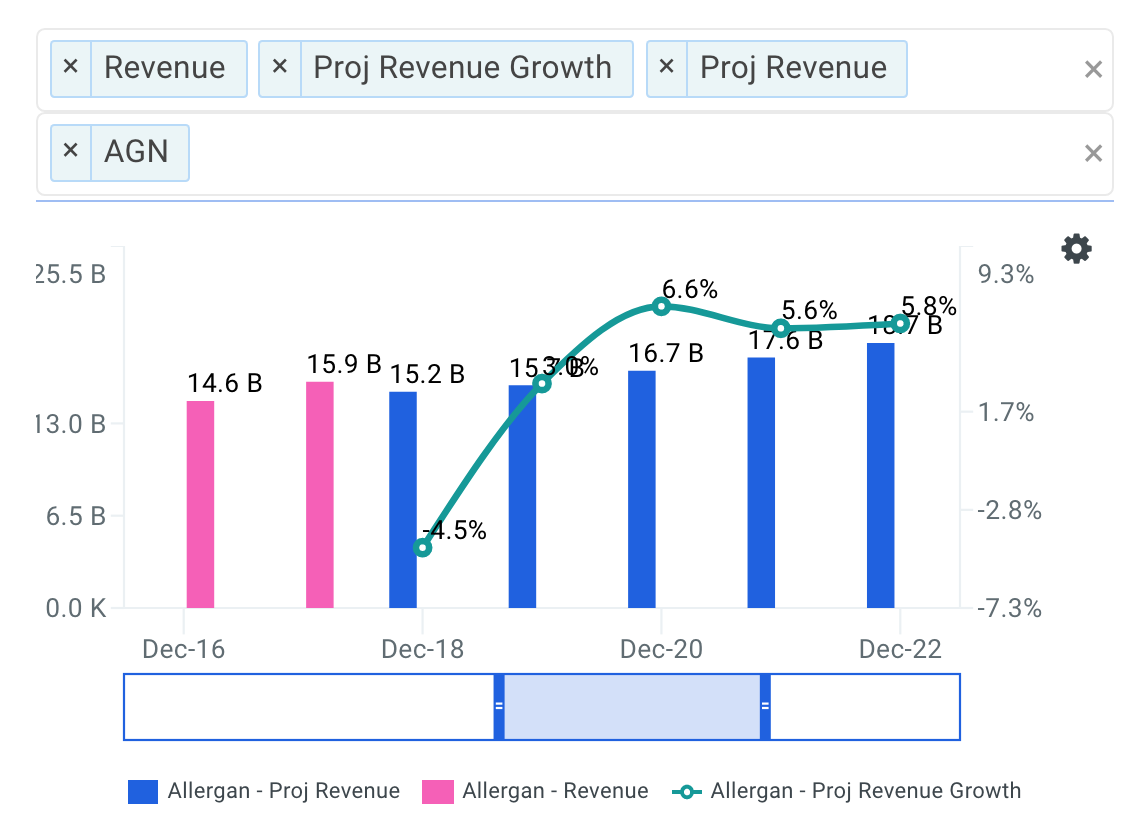Allergan plc (NYSE: AGN) investors have enjoyed seeing the stock price increase by 16.9% over the last month. As a large-cap stock with high coverage by analysts, you could assume any recent changes in the company’s outlook is already priced into the stock. However, could the stock still be trading at a relatively cheap price? Let’s take a look at the company's expected growth and valuation based on its most recent financial data to see if there is further upside moving forward.
What Is Allergan Worth?
According to our 5 valuation models, Allergan seems to be fairly priced in the market at 2.4% below its intrinsic value. This means if you were to buy Allergan today, you'd be paying a reasonable price for it. If you believe that the stock is really worth $166.15, then there isn’t much room for the share price to appreciate beyond where it’s currently trading.
| Analysis | Model Fair Value | Upside (Downside) |
|---|---|---|
| 10-yr DCF Revenue Exit | $252.03 | 55.3% |
| 5-yr DCF Revenue Exit | $207.85 | 28.1% |
| Peer Revenue Multiples | $135.96 | -16.2% |
| Peer EBITDA Multiples | $123.11 | -24.1% |
| Dividend Discount Model (multi-stage) | $111.78 | -31.1% |
| Average | $166.15 | 2.4% |
Click on any of the analyses above to view the latest model with real-time data.
Although, there may be an opportunity to buy in the future. This is because Allergan’s beta (a measure of share price volatility) is high, meaning its price movements will be exaggerated relative to the rest of the market. If the market is bearish, the company’s shares will likely fall by more than the rest of the market, providing a prime buying opportunity.
How Much Growth Will Allergan Generate?
Future outlook is an important aspect when you’re looking at buying a stock, especially if you are an investor looking for growth in your portfolio. Buying a great company with a robust outlook at a cheap price is always a good investment, so let’s also take a look at the company’s future expectations.

source: finbox.io data explorer
With Allergan's relatively muted top-line growth of 3.2% expected over the next five years on average, growth doesn’t seem like a key catalyst for a buying decision, at least in the short to medium-term.
Next Steps
While many investors tend to categorize stocks as either value or growth plays, the most successful investors view growth in conjunction with a company's value. Take legendary investor Peter Lynch for example, who is widely known for popularizing the term growth at a reasonable price (GARP).
GARP is a strategy that combines aspects of both growth and value investing techniques by finding high growth companies that don't trade at overly high valuations. In the application of this strategy, Lynch achieved 29% annualized returns as the manager of Fidelity's Magellan Fund from 1977 to 1990. Needless to say the importance of analyzing a company's fair value in addition to its growth prospects.
Allergan's future growth is relatively low and the stock appears fairly valued at the moment according to our valuation models. As a shareholder, you may have already conducted your fundamental analysis on the company and the stock's recent appreciation may have been expected. Therefore, it may be time for investors to take some chips off the table. For prospective investors looking to purchase shares of Allergan, it may be worth holding off until the stock develops a larger margin of safety.
However, if you have not done so already, I highly recommend you complete your research on Allergan by taking a look at the following:
Valuation Metrics: what is Allergan's EBITDA less CapEx multiple and how does it compare to its peers? This is a helpful multiple to analyze when comparing capital-intensive businesses. View the company's EBITDA less CapEx multiple here.
Risk Metrics: how is Allergan's financial health? Find out by viewing our financial leverage data metric which plots the dollars in total assets for each dollar of common equity over time.
Efficiency Metrics: how much free cash flow does Allergan generate as a percentage of total sales? Has it been increasing or decreasing over time? Review the firm's free cash flow margin here.
Author: Brian Dentino
Expertise: financial technology, analyzing market trends
Brian is a founder at finbox.io, where he's focused on building tools that make it faster and easier for investors to research stock fundamentals. Brian's background is in physics & computer science and previously worked as a software engineer at GE Healthcare. He enjoys applying his expertise in technology to help find market trends that impact investors.
Brian can be reached at [email protected].
As of this writing, Brian did not hold a position in any of the aforementioned securities and this is not a buy or sell recommendation on any security mentioned.


